 You’ve probably seen this panel of the Rainbow Raider triumphantly shouting, “I believe in me!” (especially if you follow Lia’a Rogues blog). It’s from Brave and the Bold #194 by Mike Barr and Carmine Infantino. As a motivational therapist, Professor Andrea Wye approaches Bivolo and D-list Batman villain Dr. Double-X about their failures as super-villains, and convinces them to “Trade heroes and win.”
You’ve probably seen this panel of the Rainbow Raider triumphantly shouting, “I believe in me!” (especially if you follow Lia’a Rogues blog). It’s from Brave and the Bold #194 by Mike Barr and Carmine Infantino. As a motivational therapist, Professor Andrea Wye approaches Bivolo and D-list Batman villain Dr. Double-X about their failures as super-villains, and convinces them to “Trade heroes and win.”
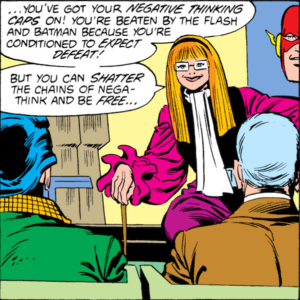
So Rainbow Raider goes after Batman, and Dr. Double-X goes after the Flash. The heroes aren’t used to fighting each other’s villains, and actually get captured. Of course they turn the tables before she’s able to learn what she wants from them, and overpower the villains before going after the mastermind. She escapes, but Flash figures she’ll return sooner or later. As far as I knew, she disappeared at that point.
I recently discovered that she does return, after all, in the opening two-parter of the 1985 Outsiders series — no surprise, also written by Barr. This was when the team had just split off from Batman, causing a title change, and moved from Gotham to Los Angeles.
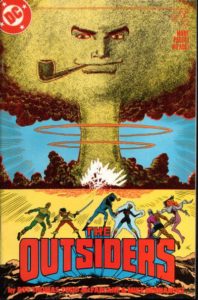 In “Nuclear Fear,” Prof. Wye stages a fake terrorist attack on a nuclear power plant near Los Angeles to observe how the city reacts. It’s research material for her next book on the psychology of fear. (Ethics, schmethics, right?)
In “Nuclear Fear,” Prof. Wye stages a fake terrorist attack on a nuclear power plant near Los Angeles to observe how the city reacts. It’s research material for her next book on the psychology of fear. (Ethics, schmethics, right?)
The Outsiders stop her team before it can make a scene, but the scientist she contacted to help plan the raid wants to go further. He wants to actually blow up Los Angeles in order to make people understand the horrors of nuclear war, and he sends a group of robots modeled after his dead family to do it. Naturally they’re called The Nuclear Family, and they’re this weird idealized 1950s family — except for the fact that they want to kill everyone. (Strange that nuclear war and twisted nostalgia for the 1950s are suddenly topical again.)
Once Wye learns about her ally’s plan, she hightails it out of town. Meanwhile the Outsiders are in a race to find the robots before they detonate themselves. In the end, the only thing they can do is destroy the robots in a normal explosion before they go critical and take out the city. The Nuclear Family is never seen again, as far as I know…and neither is Professor Wye.
I wonder if she ever finished her book?

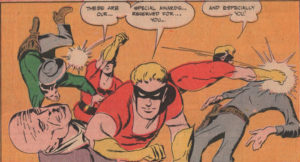
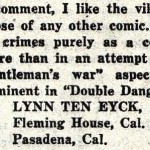
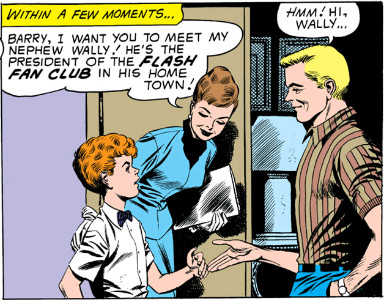 The cover features the Weather Wizard in his first appearance, while a backup story introduces Kid Flash. Iris West’s nephew Wally — a huge fan of the Flash — comes to visit her in Central City, and she arranges a surprise: Her friend Barry Allen knows the Flash, and he just might be able to introduce him!
The cover features the Weather Wizard in his first appearance, while a backup story introduces Kid Flash. Iris West’s nephew Wally — a huge fan of the Flash — comes to visit her in Central City, and she arranges a surprise: Her friend Barry Allen knows the Flash, and he just might be able to introduce him!